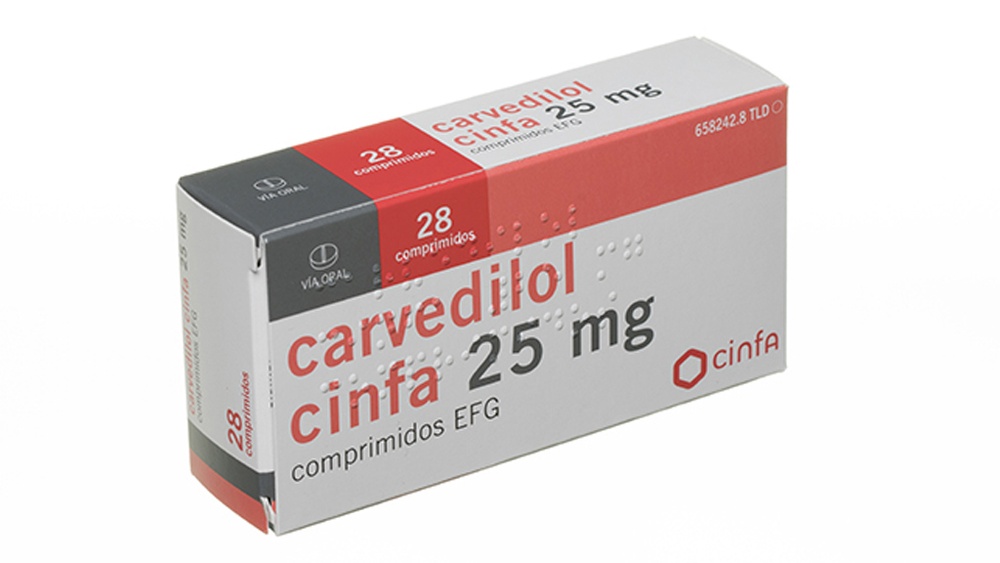

CARVEDILOL CINFAMED 25 mg TABLETS

Ask a doctor about a prescription for CARVEDILOL CINFAMED 25 mg TABLETS

How to use CARVEDILOL CINFAMED 25 mg TABLETS
Introduction
Package Leaflet: Information for the User
Carvedilol Cinfamed 25mg Tablets EFG
Read the entire package leaflet carefully before starting to take this medication, as it contains important information for you.
- Keep this package leaflet, as you may need to read it again.
- If you have any questions, consult your doctor or pharmacist.
- This medication has been prescribed to you only, and you should not give it to others, even if they have the same symptoms as you, as it may harm them.
- If you experience side effects, consult your doctor or pharmacist, even if they are not listed in this package leaflet. See section 4.
Contents of the Package Leaflet
- What is Carvedilol Cinfamed and what is it used for?
- What you need to know before taking Carvedilol Cinfamed
- How to take Carvedilol Cinfamed
- Possible side effects
- Storage of Carvedilol Cinfamed
- Contents of the pack and further information
1. What is Carvedilol Cinfamed and what is it used for?
This medication contains carvedilol as the active ingredient, which belongs to a group of medications known as alpha and beta receptor blockers. Carvedilol has antioxidant, antihypertensive (reducing blood pressure), vasodilatory, and antianginal properties. Additionally, it reduces cardiac output and has favorable effects on blood circulation at the heart level.
This medication is indicated for the treatment of:
- Symptomatic congestive heart failure (the heart has lost some of its ability to pump blood) of moderate to severe origin, either ischemic or non-ischemic.
- Essential hypertension (high blood pressure).
- Ischemic heart disease (the heart receives little blood and oxygen).
2. What you need to know before taking Carvedilol Cinfamed
Do not take Carvedilol Cinfamed:
- If you are allergic to carvedilol or any of the other components of this medication (listed in section 6).
- A type of decompensated heart failure known as class IV (the heart is unable to perform its pumping function during physical activity and at rest).
- Chronic obstructive pulmonary disease (COPD) with obstructed bronchi (difficulty breathing).
- If your liver is not functioning properly.
- Bronchial asthma.
- A heart condition consisting of second- and third-degree atrioventricular (AV) block (unless a permanent pacemaker has been implanted).
- If your heart beats slowly (less than 50 beats per minute).
- Heart failure (or shock, a state in which the heart has been so damaged that it is unable to supply enough blood to the body's organs).
- A heart condition consisting of sinoatrial node block.
- Very low blood pressure (systolic pressure less than 85 mmHg).
Warnings and precautions
Consult your doctor or pharmacist before starting to take this medication.
Inform your doctor if you have any of the following diseases:
- If you have any lung disease.
- If you are diabetic.
- If you have a heart condition.
- If you are taking other medications for heart conditions, especially if you are taking any of the following medications, you should inform your doctor: digitalis (increases the strength of the heartbeat), diuretics (increases urine production), ACE inhibitors (antihypertensive medication), calcium antagonists (antihypertensive medication), and antiarrhythmics (affect the heart rhythm).
- If you have any thyroid problems.
- If you are allergic and receiving treatment for your allergy.
- If you have circulation problems or Raynaud's phenomenon.
- If you are scheduled for surgery, inform your doctor that you are being treated with carvedilol.
- If you have a condition called pheochromocytoma.
- If you have psoriasis (a skin disease).
- If you have Prinzmetal's angina (chest pain that begins during rest without obvious causes).
- If you are going to undergo surgery with anesthesia. You should inform the anesthesiologist.
- If you use contact lenses. Carvedilol may reduce tear production.
- If you have severe skin reactions (e.g., toxic epidermal necrolysis, Stevens-Johnson syndrome).
As with all medications with beta-blocking activity, you should not stop treatment with this medication abruptly. The dose should be gradually reduced according to your doctor's instructions.
Use in athletes
This medication contains carvedilol, which may produce a positive result in doping tests.
Taking Carvedilol Cinfamed with other medications
Inform your doctor or pharmacist if you are using, have recently used, or may need to use any other medication.
This is very important because taking several medications at the same time can increase or decrease their effect. Therefore, you should not take this medication with any other medication unless your doctor has allowed it.
Note that these instructions may also apply to medications that have been used before or may be used after.
It is essential that you inform your doctor if you are taking or have recently taken any of the following medications:
- Fluoxetine and paroxetine (medications for depression).
- Cyclosporine (a medication used to prevent rejection in transplants).
- Digoxin, Verapamil, Diltiazem, and antiarrhythmic medications (medications used to treat heart problems and high blood pressure).
- Amiodarone (a medication used to treat certain heart problems).
- Certain analgesics such as aspirin and ibuprofen (NSAIDs).
- Other medications for high blood pressure, barbiturates, phenothiazines, tricyclic antidepressants, vasodilators, and alcohol.
- Medications for diabetes (including insulin and oral antidiabetics).
- Clonidine (a medication used to control high blood pressure or migraines).
- Rifampicin (a medication used to treat infections).
- Cimetidine (a medication used to treat stomach problems).
- Inducers or inhibitors of hepatic metabolism (medications that modify the elimination of other medications from the body).
- Monoamine oxidase inhibitors (medications for depression).
- Beta-agonist bronchodilators (medications used to improve respiratory capacity, such as in asthma).
Taking Carvedilol Cinfamed with food and drinks
You should avoid drinking alcohol during treatment with this medication, as it may alter its effects.
Your doctor or pharmacist will inform you about the meals with which it is recommended to take the medication.
Pregnancy and breastfeeding
If you are pregnant or breastfeeding, think you may be pregnant, or plan to become pregnant, consult your doctor before using this medication.
The use of this medication is not recommended during pregnancy and breastfeeding.
Carvedilol may cause fetal death in the womb, as well as premature births. Additionally, adverse effects may occur in the fetus and newborn. After birth, the newborn is at a higher risk of suffering heart and lung problems.
Carvedilol passes into breast milk, so its use is not recommended during breastfeeding.
Driving and using machines
Occasionally, this medication may impair your ability to drive or operate machines. This occurs especially when starting or changing treatment and when taken with alcohol.
Carvedilol Cinfamed contains lactose
If your doctor has told you that you have an intolerance to certain sugars, consult with them before taking this medication.
3. How to take Carvedilol Cinfamed
Follow your doctor's instructions for taking this medication exactly. If you are unsure, consult your doctor or pharmacist again.
Essential hypertension:
Adults:
Oral administration. The recommended starting dose is 12.5 mg once a day for the first two days. Then, the recommended dose is 25 mg once a day. If necessary, your doctor may increase the dose you receive (at intervals of at least two weeks) up to 50 mg once a day or in two doses of 25 mg each.
Elderly patients: Oral administration. The recommended starting dose is 12.5 mg once a day, which is usually sufficient. If the response is not adequate, your doctor will adjust the dose (at intervals of at least two weeks).
Ischemic heart disease:
Adults:
Oral administration. The recommended starting dose is 12.5 mg twice a day (a total of 25 mg per day) for the first two days. Then, the recommended dose is 25 mg twice a day (a total of 50 mg per day). If necessary, your doctor may increase the dose you receive (at intervals of at least two weeks) up to 100 mg once a day or in two doses of 50 mg each.
Elderly patients: Oral administration. The maximum recommended dose for elderly patients is 50 mg administered in divided doses (twice a day).
Treatment of symptomatic congestive heart failure
Adults and elderly patients:
Oral administration. Your doctor will tell you individually the dose you should take, closely monitoring you during dose adjustments.
If you are using medications for heart conditions (digitalis) or blood pressure control (diuretics and/or ACE inhibitors) and before starting treatment with this medication, your doctor will adjust the amount of these medications you should take.
In any case, the recommended starting dose for this medication in the treatment of symptomatic congestive heart failure is 3.12 mg twice a day (a total of 6.25 mg per day) for two weeks. If you tolerate this dose well, it can be increased later (at intervals of at least two weeks) up to 6.25 mg twice a day (a total of 12.5 mg per day).
Your doctor may prescribe higher doses of this medication later (after at least two weeks).
If you weigh less than 85 kg, the maximum recommended dose is 25 mg twice a day (a total of 50 mg per day). If your weight is over 85 kg, the maximum recommended dose is 50 mg twice a day (100 mg per day).
Your doctor will indicate the duration of your treatment with this medication.
As a general rule, regardless of your condition, withdrawal of this medication should be done gradually over several days, or the dose can be reduced by half every three days.
Use in children and adolescents
This medication is not recommended for use in children and adolescents under 18 years of age due to insufficient data on safety and efficacy.
Guidelines for correct administration
Take the tablets with a sufficient amount of liquid, a glass of water.
If you have congestive heart failure (your heart has lost some of its ability to pump blood and may cause difficulty breathing, weakness, and fluid accumulation), you should take this medication while eating to avoid dizziness when standing up.
Remember to take your medication.
If you take more Carvedilol Cinfamed than you should
If you take more Carvedilol Cinfamed than you should, contact your doctor or go to the nearest hospital immediately. Bring the medication with you.
In case of overdose or accidental ingestion, consult the Toxicology Information Service, Telephone 91 562.04.20.
If you forget to take Carvedilol Cinfamed
Do not take a double dose to make up for forgotten doses.
If you stop taking Carvedilol Cinfamed
Treatment with this medication should not be stopped abruptly, especially if you have ischemic heart disease, a condition that causes the heart to not pump blood well. Your doctor will gradually reduce the dose over a few days until you stop taking the medication completely.
If you have any other questions about the use of this medication, ask your doctor or pharmacist.
4. Possible side effects
Like all medications, this medication can cause side effects, although not everyone will experience them.
Side effects are classified as: very common (may affect more than 1 in 10 people), common (may affect up to 1 in 10 people), uncommon (may affect up to 1 in 100 people), rare (may affect up to 1 in 1,000 people), very rare (may affect up to 1 in 10,000 people), and frequency not known (cannot be estimated from available data).
Infections and infestations
Common: Bronchitis, pneumonia, upper respiratory tract infections, urinary tract infections.
Disorders of the nervous system
Very common: Headache, dizziness, and weakness, which are usually mild and occur mainly at the start of treatment.
Common: Presyncope, syncope (fainting), especially at the beginning of treatment.
Uncommon: Paresthesia (tingling sensation).
Psychiatric disorders:
Common: Depressed mood, depression.
Uncommon: Sleep disorders.
Cardiac disorders
Very common: Increased heart failure (the heart has lost some of its ability to pump blood).
Common: Bradycardia (decreased heart rate), fluid overload, increased blood volume in the body.
Uncommon: Atrioventricular (AV) block (heart problems) and angina pectoris (chest pain).
Vascular disorders:
Very common: Low blood pressure.
Common: Postural hypotension (dizziness when standing up or changing body position), peripheral circulation disorders (cold hands and feet), increased symptoms in patients with intermittent claudication (increased pain in the legs when walking) or Raynaud's phenomenon (decreased blood flow to the fingers and toes, ears, and nose), hypertension.
Respiratory, thoracic, and mediastinal disorders
Common: Asthma and difficulty breathing in predisposed patients, fluid accumulation in the lungs.
Rare: Nasal congestion.
Gastrointestinal disorders
Common: Gastrointestinal disorders with symptoms such as nausea, diarrhea, abdominal pain, indigestion, vomiting.
Uncommon: Constipation.
Rare: Dry mouth.
Disorders of the skin and subcutaneous tissue
Uncommon: Skin reactions (e.g., allergic exanthem, dermatitis, urticaria, itching, psoriasis, skin lesions of lichen planus type).
Frequency not known: Hair loss, severe skin reactions (e.g., toxic epidermal necrolysis, Stevens-Johnson syndrome).
Disorders of the blood and lymphatic system
Common: Decreased red blood cell count (anemia).
Rare: Decreased platelet count (thrombocytopenia).
Very rare: Decreased white blood cell count (leukopenia).
Hepatobiliary disorders
Very rare: Alterations in serum transaminases (changes in the amount of certain liver enzymes in the blood).
Eye disorders
Common: Decreased tear production (dry eye), eye irritation, vision changes.
Renal and urinary disorders
Common: Acute renal failure (the kidney is not functioning properly) and renal function disorders in patients with diffuse vascular disease and/or altered renal function.
Rare: Urination problems.
Frequency not known: Urinary incontinence in women (disappears when the medication is stopped).
Disorders of the immune system
Very rare: Allergic reactions.
Musculoskeletal and connective tissue disorders
Common: Pain in the limbs.
Disorders of the reproductive system and breast
Uncommon: Impotence.
Metabolic and nutritional disorders
Common: Worsening of blood sugar control in diabetic patients (hyperglycemia, hypoglycemia), weight gain, increased cholesterol in the blood.
Frequency not known: It is possible that latent diabetes mellitus may manifest or that existing diabetes may worsen.
General disorders and administration site conditions
Very common: Fatigue.
Common: Pain, edema (fluid retention, swelling of the legs, ankles, and feet).
If you consider that any of the side effects you are experiencing is serious or if you notice any side effect not mentioned in this package leaflet, inform your doctor or pharmacist.
Reporting of side effects
If you experience any type of side effect, consult your doctor, pharmacist, or nurse, even if it is a possible side effect not listed in this package leaflet. You can also report them directly through the Spanish Pharmacovigilance System for Human Use Medications: https://www.notificaram.es. By reporting side effects, you can contribute to providing more information on the safety of this medication.
i
5. Storage of Carvedilol Cinfamed
Keep out of sight and reach of children.
Do not store above 30°C. Store in the original package to protect it from moisture.
Do not use this medication after the expiration date shown on the package after CAD. The expiration date is the last day of the month indicated.
Medications should not be disposed of through wastewater or household waste. Deposit the packaging and medications you no longer need at the SIGRE collection point in the pharmacy. If in doubt, ask your pharmacist how to dispose of the packaging and medications you no longer need. This will help protect the environment.
6. Packaging Content and Additional Information
Composition of Carvedilol Cinfamed
- The active ingredient is carvedilol. Each tablet contains 25 mg of carvedilol.
- The other components are: Core: microcrystalline cellulose, lactose monohydrate, povidone, crospovidone, anhydrous colloidal silica, magnesium stearate (E470b); Coating: titanium dioxide (E-171), polydextrose, hypromellose, triethyl citrate, macrogol 8000.
Appearance of the Product and Packaging Content
The Carvedilol Cinfamed tablets are white, oval, film-coated tablets with a score line on both sides and marked with "25" on one side.
This medication is presented as PVC/Aclar/Al blisters in packs of 28 or 500 tablets.
Marketing Authorization Holder and Manufacturer
Holder
Laboratorios Cinfa, S.A.
Carretera Olaz-Chipi, 10. Polígono Industrial Areta
31620 Huarte (Navarra) – Spain.
Manufacturers:
ROVI Pharma Industrial Services, S.A.
Vía Complutense, 140
Alcalá de Henares
28805 (Madrid)
Spain
Or
Laboratorios Cinfa, S.A.
Carretera Olaz-Chipi, 10. Polígono Industrial Areta
31620 Huarte (Navarra) – Spain
Date of the Last Revision of this Prospectus:June 2016
Detailed and updated information on this medication is available on the website of the Spanish Agency for Medicines and Health Products (AEMPS) http://www.aemps.gob.es/
You can access detailed and updated information about this medication by scanning the QR code included in the prospectus and packaging with your mobile phone (smartphone). You can also access this information at the following internet address:
https://cima.aemps.es/cima/dochtml/p/65869/P_65869.html
QR code to: https://cima.aemps.es/cima/dochtml/p/65869/P_65869.html
.

How much does CARVEDILOL CINFAMED 25 mg TABLETS cost in Spain ( 2025)?
The average price of CARVEDILOL CINFAMED 25 mg TABLETS in November, 2025 is around 6.04 EUR. Prices may vary depending on the region, pharmacy, and whether a prescription is required. Always check with a local pharmacy or online source for the most accurate information.
- Country of registration
- Average pharmacy price6.04 EUR
- Active substance
- Prescription requiredYes
- Manufacturer
- This information is for reference only and does not constitute medical advice. Always consult a licensed doctor before taking any medication. Oladoctor is not responsible for medical decisions based on this content.
- Alternatives to CARVEDILOL CINFAMED 25 mg TABLETSDosage form: TABLET, 25 mgActive substance: carvedilolManufacturer: Almus Farmaceutica S.A.U.Prescription requiredDosage form: TABLET, 6.25 mgActive substance: carvedilolManufacturer: Almus Farmaceutica S.A.U.Prescription requiredDosage form: TABLET, 25 mgActive substance: carvedilolManufacturer: Laboratorios Alter S.A.Prescription required
Alternatives to CARVEDILOL CINFAMED 25 mg TABLETS in other countries
The best alternatives with the same active ingredient and therapeutic effect.
Alternative to CARVEDILOL CINFAMED 25 mg TABLETS in Poland
Alternative to CARVEDILOL CINFAMED 25 mg TABLETS in Ukraine
Online doctors for CARVEDILOL CINFAMED 25 mg TABLETS
Discuss dosage, side effects, interactions, contraindications, and prescription renewal for CARVEDILOL CINFAMED 25 mg TABLETS – subject to medical assessment and local rules.









